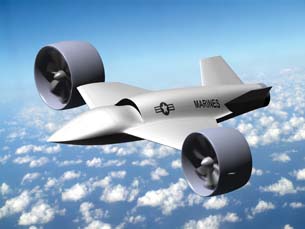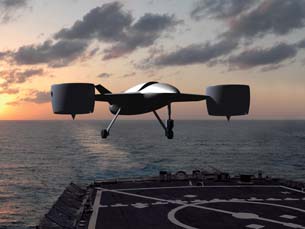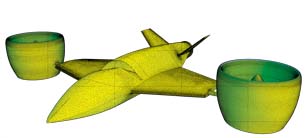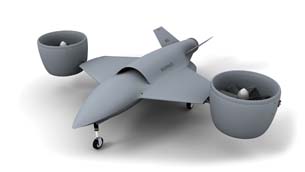Latest News
March 22, 2011
By DE Editors
American Dynamics Flight Systems (ADFS) is an advanced technology development company located in the United States; it develops innovative aerospace defense systems and technologies.
 |  |
American Dynamics’ main product, the AD-150, is a tilt-duct vertical takeoff and landing (VTOL) unmanned aerial vehicle (UAV) capable of achieving high forward airspeeds. The aircraft uses a pair of rotating wing tip mounted ducted fans to provide the vertical lift and forward thrust needed to approach 300kts. The AD-150 has been developed around upcoming U.S. Marine Corps requirements for a high-speed VTOL UAV capable of operating in a shipboard maritime environment.
ADFS recognized a problem with the amount of time it took on its current computing infrastructure to simulate the static and dynamic flight conditions experienced during transition flight. The challenge was to reduce the computational time from the approximately 3,000 hours required to produce the static data for the simulation model and the 93.4 hours per second of flight time it took to produce the transient flight data. ADFS looked at the latest in high-performance computing (HPC) cluster technology to significantly improve its time-to-solution for modeling the AD-150.
Focusing on its engineering challenge, ADFS asked for help to determine the performance, scaling and optimal HPC configuration to run its complex and high-fidelity flight simulation model. ADFS partnered with QLogic, CD-adapco, Dell and Intel to find the answers to these questions.
 The first test developed the steady state data required for the simulation. On ADFS’ existing computing platforms, the generation of the steady state data would have required approximately 3,000 hours of computational time. Using the Dell Sapphire cluster at the QLogic NETtrack Developer Center, ADFS was able to generate the necessary data in approximately 48 hours, improving the time-to-solution more than 62 times. |
NDC and Test Drive Program
ADFS took advantage of QLogic’s NETtrack Developer Center (NDC) Test Drive program. At the NDC, ADFS could “test fly” its AD-150 simulation model on a Dell PowerEdge HPC, cluster powered by the Intel Xeon Processor 5500 series and the QLogic TrueScale InfiniBand high-performance interconnect.
The QLogic NDC provides QLogic partners and customers with HPC infrastructure to test, profile and certify their HPC applications on high-core-count clusters, using the industry’s leading-edge processor technologies along with the latest in storage technologies.
The QLogic NDC Test Drive program allows customers to test their models and simulation on a range of cluster configurations. The NDC testing infrastructure provides customers a test environment that exceeds their own, which allows them to test the scaling and performance capabilities of their applications prior to making a purchase. This allows customers like ADFS to determine the optimal configuration for their models/simulations, budget and business requirements.
The AD-150 steady state propulsion model consists of a single propulsion unit, complete with a rotating fan, nacelle, spinner cone, core cowling, support pipes and a large cylindrical computational domain. The mesh was configured as an unstructured polyhedral mesh with structured prism layers around the boundaries. The mesh size is approximately 5.3 million cells.
The physics modeling was configured as three-dimensional, steady state, with moving reference frame (MRF) and K-Epsilon turbulence. The rotating fan and spinner cone were modeled as an MRF region; all other geometry was modeled as a stationary region. In-place interfaces were configured between the two regions.
The steady model was run through an automated process that generated aerodynamic and performance data for the propulsion system for flight conditions stored in a test matrix, representative of the relevant flight envelope of the AD-150. The test matrix included variations in angle-of-attack, forward airspeed and fan speed. The data was then processed and fit to mathematical curves to allow integration of the data into any flight condition modeled in the unsteady model.
 The second test generated the transient simulations. On ADFS’ existing computing platforms, this test required 93.4 hours of computing time per second of physical time in the simulations. Using the Dell Sapphire cluster with QLogic TrueScale InfiniBand high performance interconnect, ADFS reduced the computing time to 2.4 hours per second of physical time in the simulations. This reduced the time-to-solution by 97%. |
The AD-150 transient model consisted of the airplane fuselage and two propulsion systems. The propulsion systems included all relevant geometry, except for the rotating fans. Boundary conditions were put in place of the rotating fans. The data for the boundary conditions was dynamically generated during model execution for a given flight condition based on the data generated from the static runs.
A large cylindrical computational domain was created around the entire aircraft geometry, and separate cylindrical volumes were created around the propulsion systems to allow the propulsion systems to tilt to any angle (from vertical to horizontal) without re-meshing the model. In-place interfaces were created between the propulsion system volumes and the main computational domain. The mesh was configured as an unstructured polyhedral mesh, with structured prism layers around the boundaries. The mesh size was approximately six million cells.
The physics modeling was configured as a three-dimensional, implicit unsteady, 6 degree-of-freedom (6-DoF) model with K-Epsilon turbulence. An automated program was created to tilt the ducts, change the airplane’s angle of attack, and change the fan RPM between time steps through feedback control loops. Outer loops were created to model multiple takeoff, approach, and forward flight profiles.
Tested Configurations
The AD-150 simulation model was run internally at ADFS on a Sun Fire X2200 M2 with 12GB of RAM, on Linux x86_64 platforms.
The ADFS NDC Test Drive was run on the Dell “Sapphire” cluster, consisting of 16 Dell PowerEdge R610 compute nodes and 1 NFS server node. Each compute node had a dual quad-core Intel Xeon 5570 with 2.93GHz CPUs and 24GB of memory. The Dell HPC cluster (based on the Intel Xeon 5570 processor) had a total of 128 cores and 384GB of memory.
Key Solution Technologies
The dramatic improvement in the performance of ADFS AD-150 simulation model was enabled by the following key technologies.
CD-adapco STAR-CCM+: From CAD to post-processing, STAR-CCM+ delivers the entire CFD process in a single integrated software environment. This unique approach brings ease-of-use and automation to CAD preparation, meshing, model set-up and iterative design studies, enabling engineers to deliver better results, faster. Innovations such as built-in surface-wrapping, advanced automated meshing (creating either polyhedral or predominantly hexahedral volume meshes), and the ability to “copy and paste” components between models have given STAR-CCM+ a reputation for producing quality results in a single code with minimum user effort.
Written “from the ground up” using object-oriented programming and the latest software technology, combined with outstanding ease- of-use and accuracy, STAR-CCM+ is an entirely new concept in CFD and engineering simulation, according to the company.
Dell PowerEdge R610 Servers: The Dell PowerEdge R610 is a key building block for today’s HPC clusters. Designed for versatility and high performance, it provides many of the performance, system management and energy-efficiency features needed for today’s performance-demanding applications, as well as the scalability necessary to support the most demanding application processing environments. This general-purpose, Intel-based, two-socket 1U server is ideal for HPC clusters that require a dense, highly available single- or dual-processor server at an excellent value.
Combined with a new suite of system management solutions and flexible services, these new servers help lower operating costs, reduce complexity, and free up resources so users can do more with their IT environment, according to the company.
Intel Xeon Processor 5500 Series: The Intel Xeon processor 5500 series automatically and intelligently adjusts server performance according to the application’s needs for a performance gain up nine times better than single-core servers (and at 18% less operating power). This processor has a 9:1 server consolidation ratio, which reduces operating costs by up to 90%, resulting in an estimated eight-month return on a new server investment.
Two-processor servers based on the Intel Xeon processor 5500 series have up to eight computation engines, 16 threads per two-socket platform with Intel Hyper-Threading technology, and as much as 3.5 times more bandwidth than previous generations. With intelligent performance technology and a new high-bandwidth interconnect architecture, the Intel Xeon processor 5500 series delivers up to four times greater performance for HPC applications than Intel dual-core processors.
QLogic TrueScale InfiniBand: TrueScale InfiniBand is architected to make effective use of multi-core nodes by providing ultra-low latency and significant message rate scalability. TrueScale InfiniBand provides the industry’s highest performing standards-based interconnect on which to build an HPC cluster, according to the company. QLogic offers a comprehensive end-to-end product portfolio that includes multi-protocol Fabric Directors, Edge Fabric switches and an InfiniBand adapter, as well as a complete software suite to install, operate and maintain a high-performance interconnect fabric.
Application requirements from 12 to 864 InfiniBand ports can be supported in a single chassis. Multi-chassis fabrics that support thousands of host nodes can be constructed to meet the most demanding compute cluster requirements. This offering, combined with the industry’s only Fabric Management tools that enable an administrator to install and boot a fabric in minutes, helps to satisfy the growing demand for high-performance computational clusters and grids.
Many Benefits
Companies such as ADFS can realize significant benefits from today’s HPC technologies, especially given the latest advances in multi-core/multi-processor performance. These HPC cluster-computing resources can be interconnected with a high-performance network to eliminate bottlenecks and improve the efficiency of key applications. An optimized HPC cluster has a number of benefits, including:
• Improved time-to-solution: Run models and simulations faster.
• Better design accuracy: Run models with increased complexity.
• Improved designs: Analyze multiple designs in a given period of time.
• Increased design/engineering team efficiency: Simultaneously run multiple simulations.
• Reduced costs: Create better simulations and less physical prototyping.
The testing at the QLogic NDC showed ADFS that it could significantly reduce its time-to-solution, and that the Dell PowerEdge R610-based cluster with TrueScale InfiniBand could provide the performance and scaling capabilities to allow ADFS to further increase the complexity and fidelity of its simulation models going forward.
Subscribe to our FREE magazine, FREE email newsletters or both!
Latest News
About the Author
DE’s editors contribute news and new product announcements to Digital Engineering.
Press releases may be sent to them via [email protected].






